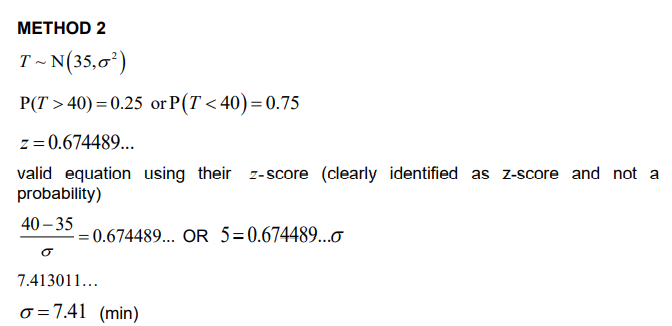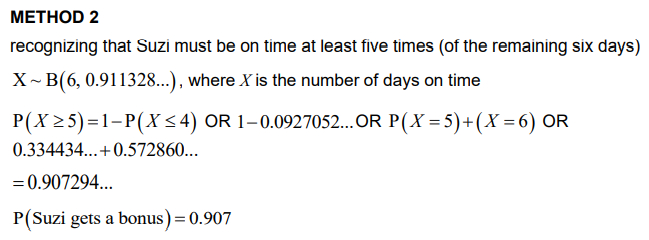Question
A bakery makes two types of muffins: chocolate muffins and banana muffins.
The weights, C grams, of the chocolate muffins are normally distributed with a mean of 62g and standard deviation of 2.9g.
(a) Find the probability that a randomly selected chocolate muffin weighs less than 61g.
(b) In a random selection of 12 chocolate muffins, find the probability that exactly 5 weigh less than 61g.
The weights, B grams, of the banana muffins are normally distributed with a mean of 68 g and standard deviation of 3.4g.
Each day 60% of the muffins made are chocolate.
On a particular day, a muffin is randomly selected from all those made at the bakery.
(c) (i) Find the probability that the randomly selected muffin weighs less than 61 g .
(ii) Given that a randomly selected muffin weighs less than 61g, find the probability that it is chocolate.
The machine that makes the chocolate muffins is adjusted so that the mean weight of the chocolate muffins remains the same but their standard deviation changes to σ g. The machine that makes the banana muffins is not adjusted. The probability that the weight of a randomly selected muffin from these machines is less than 61g is now 0.157.
(d) Find the value of σ .
Answer/Explanation
Ans:
(a) P(C< 61)
= 0.365112…
= 0.365
(b) recognition of binomial eg X ˜ B(12,0.365…)
P( x = 5) = 0.213666…
= 0.214
(c) (i) Let CM represent ‘chocolate muffin’ and BM represent ‘banana muffin’
P(B<61) = 0.0197555…
EITHER
P(CM) × P(C<61|CM) + P(BM) × P(B<61|BM) (or equivalent in words)
OR
tree diagram showing two ways to have a muffin weigh < 61
THEN
(0.6 × 0.365…) + (0.4 × 0.0197…)
= 0.226969…
= 0.227
(ii) recognizing conditional probability
Note: Recognition must be shown in context either in words or symbols, not just P (A|B) .
\(\frac{0.6\times 0.365112…}{0.22699…}\)
= 0.965183…
= 0.965
(d) METHOD 1
P(CM) × P(C<61|CM) + P(BM) × P(B<61|BM) = 0.157
(0.6 × P(C<61))+ (0.4 × 0.0197555….) = 0.157
P(C<61) = 0.248496….
attempt to solve for σ using GDC
Note: Award (M1) for a graph or table of values to show their P (C<61) with a variable standard deviation.
σ =1.47225…
σ = 1.47 (g)
METHOD 2
P(CM) × P(C<61|CM) + P(BM) × P(B<61|BM) = 0.157
(0.6 × P(C<61))+ (0.4 × 0.0197555….) = 0.157
P(C<61) = 0.248496….
use of inverse normal to find z score of their P(C< 61)
z = −0.679229…
correct substitution
\(\frac{61-62}{\sigma }\) = -0.679229…
σ =1.47225…
σ = 1.47 (g)
Question
The time it takes Suzi to drive from home to work each morning is normally distributed with a mean of 35 minutes and a standard deviation of σ minutes. On 25% of days, it takes Suzi longer than 40 minutes to drive to work.
(a) Find the value of σ.
(b) On a randomly selected day, find the probability that Suzi’s drive to work will take longer than 45 minutes.
Suzi will be late to work if it takes her longer than 45 minutes to drive to work. The time it takes to drive to work each day is independent of any other day.
Suzi will work five days next week.
(c) Find the probability that she will be late to work at least one day next week.
(d) Given that Suzi will be late to work at least one day next week, find the probability that she will be late less than three times.
Suzi will work 22 days this month. She will receive a bonus if she is on time at least 20 of those days.
So far this month, she has worked 16 days and been on time 15 of those days.
(e) Find the probability that Suzi will receive a bonus.
Answer/Explanation
Ans:
(a) METHOD 1
T ∼ N(35, σ2 )
P( T >40) = 0.25 or P(T< 40) = 0.75
attempt to solve for σ graphically or numerically using the GDC
graph of normal curve T ∼ N(35, σ2 ) for P (T> 40) and y = 0.25 OR P( T < 40) and
y = 0.75 OR table of values for P( T < 40) or P (T> 40)
σ = 7.413011…
σ = 7.41 (min)

(b) P(T>45)
= 0.0886718…
=0.0887
(c) recognizing binomial probability
L ∼ B (5, 0.0886718…..)
P(L≥1) = 1 – P (L = 0) OR
P(L≥1) = P (L = 1) + P (L = 2) + P (L = 3) + P (L = 4) + P(L=5)
0.371400….
P(L≥1) = 0.371
(d) recognizing conditional probability in context
finding {L < 3} ∩ {L≥1) = {L=1, L=2} (may be seen in conditional probability)
P(L = 1) + P(L=2) = 0.36532…. (may be seen in conditional probability)
P (L < 3 | L ≥1) = \(\frac{0.36532…}{0.37140…}\)
0.983636…
0.984
(e) METHOD 1
recognizing that Suzi can be late no more than once (in the remaining six days)
X ~ B (6, 0.0886718…) , where X is the number of days late
P (X ≤ 1) = P (X = 0) + P (X =1)
= 0.907294…
P (Suzi gets a bonus) = 0.907
Note: The first two marks may be awarded independently.

Note: The first two marks may be awarded independently.
Question [Maximum mark: 8]
At a school, 70% of the students play a sport and 20% of the students are involved in
theatre. 18% of the students do neither activity.
A student is selected at random.
(a) Find the probability that the student plays a sport and is involved in theatre. [2]
(b) Find the probability that the student is involved in theatre, but does not play a sport. [2]
At the school 48% of the students are girls, and 25% of the girls are involved in theatre.
A student is selected at random. Let G be the event “the student is a girl” and let T be the
event “the student is involved in theatre”.
(c) Find P(G ∩ T). [2]
(d) Determine if the events G and T are independent. Justify your answer.
Answer/Explanation
(a) EITHER
\(P\left ( S \right )+P\left ( T \right )+P\left ( S{}’\cap T{}’ \right )-P\left ( S\cap T \right )=1\) OR \( P\left ( S\cup T \right )=P\left ( \left ( S{}’\cap T{}’ \right ) {}’\right )\)
\(0.7+0.2+0.18-P\left ( S\cap T \right )=1\) OR \(P\left ( S\cup T \right )=1-0.18\)
OR
a clearly labelled Venn diagram
THEN
\(P\left ( S\cap T\right )=0.08\) (accept 8%)
(b) EITHER
\(P\left ( T\cap S{}’ \right )=P\left ( T \right )-P\left ( T\cap S \right )\left ( =0.2-0.08 \right )\) OR \(P\left ( T\cap S{}’ \right )=P\left ( T\cup S \right )-P\left ( S \right )\left ( =0.82-0.7 \right )\)
OR
a clearly labelled Venn diagram including \(P\left ( S \right ),P\left ( T \right )\) and \(P\left ( S \cap T\right )\)
THEN
= 0.12 (accept 12%)
(c)\( P\left ( G \cap T\right )=P\left ( T/G \right )P\left ( G \right )\left ( 0.25\times 0.48 \right )=0.12\)
(d) METHOD 1
\(P\left ( G \right )\times P\left ( T \right )\left ( =0.48\times 0.2\right )=0.096\)
\(P\left ( G \right )\times P\left ( T \right )\neq P\left ( G\cap T \right )\Rightarrow\) G and T arer not independent
METHOD 2
\(P\left ( T|G \right )=0.25\)
\(P\left ( T|G \right )\neq P\left ( T \right )\Rightarrow\) G and T are not independent
Question: [Maximum mark: 6]
Events A and B are independent and P(A) = 3P(B).
Given that P(A ∪ B) = 0.68, find P(B).
Answer/Explanation
Ans:
P(A ∪ B) = P (A) + P(B) – P (A ∩ B) = 0.68
substitution of P(A). P(B) for P (A ∩ B) in P(A ∪ B)
P(A) + P(B) – P(A) P(B) (=0.68)
substitution of 3P(B) for P(A)
3P(B) + P(B) – 3P(B) P(B) = 0.68 (or equivalent)
Note: The first two M marks are independent of each other.
attempts to solve their quadratic equation
P(B) = 0.2, 1.133… \(\left ( \frac{1}{5},\frac{17}{15} \right )\)
\(P(B)= 0.2\left ( =\frac{1}{5} \right )\)
Note: Award A1 if both answers are given as final answers for P(B).
Question
Consider the independent events A and B . Given that \({\rm{P}}(B) = 2{\rm{P}}(A)\) , and \({\rm{P}}(A \cup B) = 0.52\) , find \({\rm{P}}(B)\) .
Answer/Explanation
Markscheme
METHOD 1
for independence \({\rm{P}}(A \cap B) = {\rm{P}}(A) \times {\rm{P}}(B)\) (R1)
expression for \({\rm{P}}(A \cap B)\) , indicating \({\rm{P}}(B) = 2{\rm{P}}(A)\) (A1)
e.g. \({\rm{P}}(A) \times 2{\rm{P}}(A)\) , \(x \times 2x\)
substituting into \({\rm{P}}(A \cup B) = {\rm{P}}(A) + {\rm{P}}(B) – {\rm{P}}(A \cap B)\) (M1)
correct substitution A1
e.g. \(0.52 = x + 2x – 2{x^2}\) , \(0.52 = {\rm{P}}(A) + 2{\rm{P}}(A) – 2{\rm{P}}(A){\rm{P}}(A)\)
correct solutions to the equation (A2)
e.g. \(0.2\), \(1.3\) (accept the single answer \(0.2\))
\({\rm{P}}(B) = 0.4\) A1 N6
[7 marks]
METHOD 2
for independence \({\rm{P}}(A \cap B) = {\rm{P}}(A) \times {\rm{P}}(B)\) (R1)
expression for \({\rm{P}}(A \cap B)\) , indicating \({\rm{P}}(A) = \frac{1}{2}{\rm{P}}(B)\) (A1)
e.g. \({\rm{P}}(B) \times \frac{1}{2}{\rm{P}}(B)\) , \(x \times \frac{1}{2}x\)
substituting into \({\rm{P}}(A \cup B) = {\rm{P}}(A) + {\rm{P}}(B) – {\rm{P}}(A \cap B)\) (M1)
correct substitution A1
e.g. \(0.52 = 0.5x + x – 0.5{x^2}\) , \(0.52 = 0.5{\rm{P}}(B) + {\rm{P}}(B) – 0.5{\rm{P}}(B){\rm{P}}(B)\)
correct solutions to the equation (A2)
e.g. 0.4, 2.6 (accept the single answer 0.4)
\({\rm{P}}(B) = 0.4\) (accept \(x = 0.4\) if x set up as \({\rm{P}}(B)\) ) A1 N6
[7 marks]
Question
Let \(A\) and \(B\) be independent events, where \({\text{P}}(A) = 0.3\) and \({\text{P}}(B) = 0.6\).
Find \({\text{P}}(A \cap B)\).
Find \({\text{P}}(A \cup B)\).
On the following Venn diagram, shade the region that represents \(A \cap B’\).
Find \({\text{P}}(A \cap B’)\).
Answer/Explanation
Markscheme
correct substitution (A1)
eg \(0.3 \times 0.6\)
\({\text{P}}(A \cap B) = 0.18\) A1 N2
[2 marks]
correct substitution (A1)
eg \({\text{P}}(A \cup B) = 0.3 + 0.6 – 0.18\)
\({\text{P}}(A \cup B) = 0.72\) A1 N2
[2 marks]
A1 N1
appropriate approach (M1)
eg \(0.3 – 0.18,{\text{ P}}(A) \times {\text{P}}(B’)\)
\({\text{P}}(A \cap B’) = 0.12\) (may be seen in Venn diagram) A1 N2
[2 marks]
Question
Two events \(A\) and \(B\) are such that \({\text{P}}(A) = 0.2\) and \({\text{P}}(A \cup B) = 0.5\).
Given that \(A\) and \(B\) are mutually exclusive, find \({\text{P}}(B)\).
Given that \(A\) and \(B\) are independent, find \({\text{P}}(B)\).
Answer/Explanation
Markscheme
correct approach (A1)
eg \(0.5 = 0.2 + {\text{P}}(B),{\text{ P}}(A \cap B) = 0\)
\({\text{P}}(B) = 0.3\) A1 N2
[2 marks]
Correct expression for \({\text{P}}(A \cap B)\) (seen anywhere) A1
eg \({\text{P}}(A \cap B) = 0.2{\text{P}}(B),{\text{ }}0.2x\)
attempt to substitute into correct formula for \({\text{P}}(A \cup B)\) (M1)
eg \({\text{P}}(A \cup B) = 0.2 + {\text{P}}(B) – {\text{P}}(A \cap B),{\text{ P}}(A \cup B) = 0.2 + x – 0.2x\)
correct working (A1)
eg \(0.5 = 0.2 + {\text{P}}(B) – 0.2{\text{P}}(B),{\text{ }}0.8x = 0.3\)
\({\text{P}}(B) = \frac{3}{8}{\text{ }}( = 0.375,{\text{ exact}})\) A1 N3
[4 marks]
Question
Let \(C\) and \(D\) be independent events, with \({\text{P}}(C) = 2k\) and \({\text{P}}(D) = 3{k^2}\), where \(0 < k < 0.5\).
Write down an expression for \({\text{P}}(C \cap D)\) in terms of \(k\).
Given that \({\text{P}}(C \cap D) = 0.162\) find \(k\).
Find \({\text{P}}(C’|D)\).
Answer/Explanation
Markscheme
\({\text{P}}(C \cap D) = 2k \times 3{k^2}\) (A1)
\({\text{P}}(C \cap D) = 6{k^3}\) A1 N2
[2 marks]
their correct equation (A1)
eg\(\;\;\;2k \times 3{k^2} = 0.162,{\text{ }}6{k^3} = 0.162\)
\(k = 0.3\) A1 N2
METHOD 1
finding their \({\text{P}}(C’ \cap D)\) (seen anywhere) (A1)
eg \(0.4 \times 0.27,0.27 – 0.162,0.108\)
correct substitution into conditional probability formula (A1)
eg\(\;\;\;{\text{P}}(C’|D) = \frac{{{\text{P}}(C’ \cap D)}}{{0.27}},{\text{ }}\frac{{(1 – 2k)(3{k^2})}}{{3{k^2}}}\)
\({\text{P}}(C’|D) = 0.4\) A1 N2
METHOD 2
recognizing \({\text{P}}(C’|D) = {\text{P}}(C’)\) A1
finding their \({\text{P}}(C’) = 1 – {\text{P}}(C)\) (only if first line seen) (A1)
eg\(\;\;\;1 – 2k,{\text{ }}1 – 0.6\)
\({\text{P}}(C’|D) = 0.4\) A1 N2
[3 marks]
Total [7 marks]
